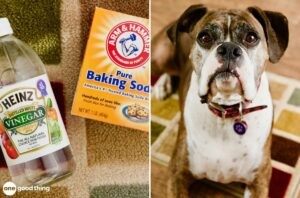Discovering pet stains on your carpet is a common woe for pet owners. Whether it’s from a new puppy in training, an aging cat, or an occasional accident, these stains can be frustrating to deal with. Not only are they unsightly, but they can also leave lingering odors that make your home less inviting. Fortunately, you don’t need harsh chemicals or expensive cleaners to tackle this problem. This guide will walk you through a simple yet highly effective method using just two common household ingredients: white vinegar and baking soda. Learn how to easily remove pet stains and odors, leaving your carpets fresh and clean.
Why This Method Works
The magic behind using white vinegar and baking soda lies in their natural cleaning properties and chemical reactions. Vinegar is a mild acid that helps to neutralize alkaline urine stains and break down stain compounds. It’s also a natural deodorizer, combating those unpleasant pet odors. Baking soda, on the other hand, is a gentle alkali that further aids in odor neutralization and acts as an absorbent, drawing the stain up and out of the carpet fibers. When combined, they create a fizzing action that helps lift stains effectively without damaging your carpet. This dynamic duo is not only effective but also a safe and eco-friendly alternative to many commercial carpet cleaners.
Step-by-Step Guide to Remove Fresh Pet Stains
For the best results, it’s crucial to act quickly when you discover a fresh pet stain. The longer the stain sits, the harder it can be to remove. Here’s a step-by-step guide to tackle those stains effectively:
Step 1: Act Fast and Blot
As soon as you notice a pet accident, grab a clean towel or thick paper towels immediately. Blot the area firmly to absorb as much of the urine as possible. Avoid rubbing, as this can spread the stain and push it deeper into the carpet fibers. Continue blotting, using fresh sections of the towel or new paper towels, until you are no longer lifting moisture. The more urine you can absorb initially, the more effective the cleaning process will be.
Step 2: Saturate with White Vinegar
Once you’ve blotted up the excess liquid, it’s time to apply white vinegar. Pour white vinegar directly onto the stain, ensuring you saturate the area thoroughly. You want the vinegar to reach down into the carpet fibers where the stain has penetrated. Don’t be shy with the vinegar, but avoid over-soaking to the point where it spreads excessively beyond the stained area.
Step 3: Apply Baking Soda
Next, generously sprinkle baking soda over the vinegar-saturated stain. You’ll notice a fizzing reaction as the baking soda interacts with the vinegar. This fizzing action is key to lifting the stain and odor from the carpet fibers. Ensure you cover the entire stained area with a good layer of baking soda for maximum effectiveness.
Step 4: Wait and Dry
Now, patience is key. Leave the baking soda and vinegar mixture to sit and dry completely. This process can take anywhere from several hours to overnight, depending on the humidity and the saturation level. To protect the area and prevent anyone from stepping on it or disturbing the cleaning process, place a large dish or container upside down over the treated area. This also serves as a reminder to revisit the spot later.
Step 5: Vacuum Thoroughly
Once the baking soda is completely dry and hardened, it’s time to vacuum. First, scoop up as much of the dried baking soda as you can with a dustpan and discard it. Then, thoroughly vacuum the entire area to remove any remaining baking soda residue. Vacuum in multiple directions to ensure you pick up all the fine particles. After vacuuming, the pet stain should be gone, and your carpet should be fresh and odor-free.
Tackling Stubborn and Old Pet Stains
While the vinegar and baking soda method is highly effective for fresh stains, older, set-in stains or lingering odors may require a bit more effort. Here are some additional tips for dealing with stubborn pet stains:
Enzyme Cleaners for Lingering Odors
If you find that a pet odor persists after using the vinegar and baking soda method, consider using an enzyme cleaner. Enzyme cleaners are specifically designed to break down the organic compounds in pet urine that cause odors. Follow the manufacturer’s instructions for application, and ensure you choose a product that is safe for carpets and pets. Enzyme cleaners can be particularly helpful for cat urine odors, which can be especially strong.
Addressing Old, Set-in Stains
Old pet stains can be more challenging to remove because they have had time to penetrate deeper into the carpet fibers and potentially set. For older stains, you can try repeating the vinegar and baking soda method multiple times. You might also consider using a specialized carpet stain remover in conjunction with the natural method. For particularly stubborn old stains, a solution of diluted hydrogen peroxide (always test in an inconspicuous area first to ensure it doesn’t discolor your carpet) can be carefully applied before the vinegar and baking soda treatment.
Pet Stains on Hardwood Floors
Pet accidents aren’t limited to carpets; they can also happen on hardwood floors. The approach to cleaning pet stains on hardwood floors differs slightly to protect the wood finish.
Sealed Hardwood
For sealed hardwood floors, avoid using undiluted vinegar, as it can be too acidic for the sealant. Instead, create a diluted vinegar solution by mixing equal parts of white vinegar and water in a spray bottle. Lightly spray the stained area and gently wipe it clean with a soft cloth. If the odor persists, you can try a solution of one part hydrogen peroxide to two parts water, but always test in a hidden area first to ensure it doesn’t affect the finish.
Unsealed Hardwood
Unsealed hardwood is more porous and absorbent, making stain removal more complex. Start by blotting the stain with cold water immediately. Then, gently scrub the area with white vinegar and rinse with cold water. Blot dry thoroughly. For stubborn stains and odors on unsealed wood, an enzymatic cleaner can be used with caution. Always test the cleaner in an inconspicuous spot first, as enzymes can potentially damage unsealed wood. In severe cases where the stain has deeply penetrated unsealed wood, sanding and refinishing the area may be necessary.
Conclusion
Removing pet stains from your carpet doesn’t have to be a stressful or expensive task. By using simple household ingredients like white vinegar and baking soda, you can effectively eliminate stains and odors, keeping your home fresh and clean. Remember to act quickly for fresh stains, be patient with the drying process, and consider enzyme cleaners for stubborn odors. With these tips, you can confidently tackle pet stains and maintain a beautiful, pet-friendly home.

